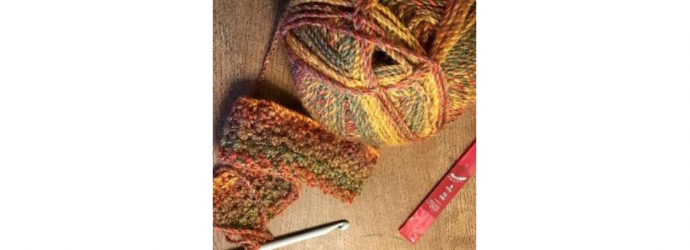
Talking head: The moment I realised I couldn’t really crochet!
- General
- 14 Dec 2021
I’ve been doing some crochet again recently; something that I pick up from time to time when my fingers are idle from a keyboard.
Whilst I would often quietly congratulate myself on the neatness of my stiches, the choices of wool colour and the fact that the (usually very small) finished article looked like it did in the pattern’s photo, I had become increasingly frustrated that I had never really learnt how to crochet. It’s true, I had made a lovely little bag for my daughter and most of an amigurumi cat (I’ve never been much of a finisher), but if I was just given a hook and a ball of wool and asked to dc2tog, ss or yrh I wouldn’t know where to begin. I can watch a video of a complicated crochet stich and copy it well, but I realised that was doing no more for me than a well-meaning adult in the class writing out a sentence for a child to go over; it looks like you’ve achieved but you are still no closer to doing it independently, or understanding the connection between what you are doing and what you are achieving.
There was nothing about the way I was learning crochet that was ever going to move my technique beyond short term memory. My frustration came from knowing that I couldn’t find a way to unravel this ball of tangled wool in my head and an understanding that this feeling is replicated by so many children of all ages in classes across the country.
As a teacher, it can look like you’ve done all the right things to enable the children in your class to embed their learning. You’ve planned pre-learning for some; overlearning within the task; multiple modalities - visual prompts, tactile resources and mini quizzes as plenaries, but still at the start of the next lesson, a few blank faces greet you. What was I missing in my own learning journey that might help a child recall their knowledge and skills when next called upon to do a similar task unaided? How could my understanding of working memory help me to apply my knowledge to improve and embed my crochet skills?
Working memory, generally stimulated from the areas in the hippocampus of the brain, is a cognitive system that holds information and allows us to process and manipulate the information in a variety of ways. Our working memory enables us to process the language we hear as well as our perception of the information we are receiving. This allows us to plan, reason and problem solve for example.
In addition, if our working memory is working well in an area, it means that we can remember a small set of instructions and recall them after a brief period of thinking or doing something different. Working memory allows us to focus attention, particularly when there are other distracting or competing demands. This system also supports the regulation of our emotions.
So why can I use muscle memory to repeat a stich over and over again across a pattern, when I can’t describe, or even demonstrate what that stich looks like if I was asked what a ‘grit stich’ is? It appears I am only storing the information relating to crochet in my short term memory, which is a bit like filing all your documents on your computer with no folders to help you retrieve them. Its fine if you want to open them up again shortly after you filed them, but little chance of finding it again after you’ve saved hundreds more files! Working memory is often described as a ‘sticky note’ which makes it easier to spot and refer to at the moment it will be useful to you. But perhaps my problem with really understanding how to crochet, is that I don’t know what information would be useful to put on my sticky note in the first place.
Other aspects that occur to me:
- Am I not practising enough? Is it essential for working memory for that overlearning to take place? Except that crochet patterns are all about overlearning – doing the same stich over and over again, so in this instance overlearning is not helping me to connect my ability to make that stitch with the further understanding that would enrich the process.
- Why is the pattern of see, do, learn not working for me? – Teachers often plan for learners to manipulate concrete resources to enable them to better understand new concepts, for example using Cuisinaire blocks in maths. But what is the key ingredient that needs to be present in an active task in order for the child to connect and make the learning relevant? Being playful is important but it doesn’t guarantee a slot in a child’s working memory.
- Is the vocabulary used in crochet not familiar enough to me? – I just don’t seem to be able to retain all the abbreviations and stich names. Each time I see tr2tog I have to search on YouTube to see what that looks like.
- Do I have limited capacity to retain the learning at the moment? – I often take to crochet when I feel the need to ‘relax’ – an enforced relaxation because my mind is thinking about many other things. I like the mind numbing nature of the repetitive stitching, but perhaps I’m not allowing myself to fully engage with the learning required. I’m using crochet as sensory relief, which is likely to be lighting up a different part of my brain. Is there a message in here for our task design for children? Is there a chance that in making a task engaging, enjoyable, multi-sensory, that sometimes we are not enabling the learning to stick?
- Am I paying too little attention? – Similar to my musings above, my pride in being able to watch television whilst crocheting, is probably not allowing me to focus in a way that might otherwise make a difference.
So how can I use my working memory more effectively? I need to be able to process the code and the language of crochet; to have a good knowledge of a range of crochet stiches; an understanding of how those two aspects of learning relate to each other and, most importantly for me, to be able to recall my learning appropriately when I next read a new crochet pattern, or decide to design my own.
It is not without irony, that writing this piece has already helped me to understand the gaps in my learning in relation to crochet and begin to put in steps to amend this. I know that I need to concentrate more effectively so that I can translate a stich name into the means by which that stich is made. Perhaps that is the first set of sticky notes I write myself ss = slip stich = hook in a stitch, yarn round and pull yarn through and on through the stitch already on the hook. I may even draw a diagram.
The real gleam of light here is that I have recognised that I know that I don’t know and that I need to do something about that. I now have agency and motivation. Supporting a child to recognise the aspect of a task that they don’t know, but which would make a difference to them moving forward, is an important first step. Within a supportive learning environment, with good relationships, accessible language and a culture of all mistakes being an opportunity to learn, all children can use more effective strategies to access their working memory and reduce their learning frustrations.
Useful resources
- Talking head – The moment I realised I couldn’t really crochet! (pdf)
- Supporting Students with Working Memory Challenges (video)
- Talking head – The moment I realised I couldn’t really crochet! (audio)





